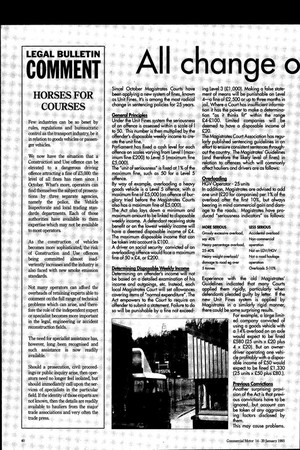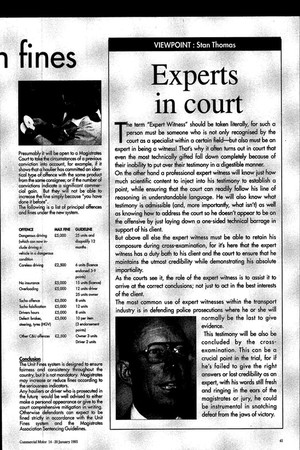fines ISinCel October fMagistrates Courts hove been applying a new
Page 42

Page 43

If you've noticed an error in this article please click here to report it so we can fix it.
system of fines, known , as Unit Fines. It's is among the most radical change in sentencing policies kr,2Byears.
„ General Principles Under the Unit Fines system the seriousness of an offence is assessed within a scale of I to 50. This number is then multiplied by the sable weekly income to crea ite e nit he. tn4iarnentlas fixed a cash level for each offence on scales varying from Level I *saximum finet20Q). toikevel 5 (maximum fine £5,000). The "unit Of serioustiss" is fixed at 1% of the maximum fine, such as 50 for a Level 5 offence.
By way of example, overloading a heavy goods vehicle is a Level 5 offence, with a maximum line of £5,000 (an offence of burglary tried before the Magistrates Courts bho has a maximum fine 40,000). ly The Act also lays down a minimum and maximum amount to be linked to disposable weekly inconss. A defendant receiving state benefit or on lowest weekly income will '41critf ckfeented disposable income of £4. The maximum disposable income that can betaken into account is £100.
A driver on social security convicted of an overloading Offence would faceomaximum PIO of 50 x or £200 Determinina Disposable Weekly Income Determining an offender's income will not he based on alletailed examination of his income and ogtgoings, etc. Instead, each !Owl Magistrate's Court will sist allowances covering items of "normal expenditure". The Act empowers to the Court to require an offender tiOuletnit ,.statement. Failure to do will be punishable bya fine not exceed (el ,000). Making a false statement ()Unmans will be punishable on Level 4—a fine of £2,500 or up to three months in jail. Where a Court has insufficient information it has the power to make a determination "as it thinks fit" within the range £4-£100. Limited companies will be deemed to have a ,disposable income of £20.
The Magistrates Court Association has regularly published sentencing guidelines in an effort to ensure consistent sentences throtslr, , out the country. The Magistrates' Guideline's' (and therefore the likely level of fines) in relation to offences which will commonly affect hauliers and drivers are as follow* Overloading HGV Operator 25 units In addition, Magistrates ore advised to add one unit (£20 for companies) per 1% of the overload after the first10%, but always bearing in mind commercial gain and damage to the roads. Mapistrates have produced "seriousness indicators" as follows: MORE SERIOUS t LESS SERIOUS Grossly excessiiii‘Ovedbod; Accidental overload say 40% Non-commercial /HGV a read haulage Overloads sitovs.
Experience with the old tvitigis` Guidelines indicated that many Courts applied them rigidly, particularly when defendants pleaded guilty by letter. If the,, new Unit Fines system is applied byr Magistrates in a similarly rigid m there could be some surprising results. For example, a large lila* ed company convicted Of using a goods vehicle wit*, ,?4a Irtpyixeptoat dtoonbeanfianxedle Heavy 25-40% Heavy we***140/ damage to road,amer 5 tonnes " 080 (25 units x EV, plus 4 x £20). But an Owner= driver operating one vehicle profitably with a disposable income of £50 would Jobe fined £1,300 (25 units 50 plus Mt Previous Convictions Another surprising provision of the Act is that previous conVidians have to be ignorediAuLer.cpsne.sxm be 161(41 Of City aggritiaV, ingtfactors :;disolpseck , by , them. ThitineY cause problems. Presumably it will be open to a Magistrates Court to take the circumstances of a previous conviction into account, for example, if it shows-that a haulier has committed an identical type of offence with the same product from the same consignee; or if the number of convictions ndicate a significant commercial gain. But they will not be. able to increase the fine simply because "you' have done it before".
The following is a list of principal offences and fines under the new system.
OFFENCE MAX FINE GUIDELINE Dangerous driving £5,000 25 units and (which can now indisqualify 12 clude driving a months vehicle in a dangerous condition Careless driving E2,500 6 units (licence endorsed 3-9 points) £5,000 15 units (licence) £5,000 12 units driver 25 units owner £5,000 8 units £5,000 12 units £5,000 8 units £5,000 10 per item (3 endorsement points) £2,500 Owner 3 units Driver 2 units No insurance Overloading Tacho offence Tacho falsification Drivers hours Defect: brakes, steering, lyres (HGV) Other C&U offences Conclusion The Unit Fines system is designed to ensure fairness and consistency throughout the country, but it is not mandatory. Magistrates may increase or reduce fines according to the seriousness indicators.
Any hauliers or driver who is prosecuted in the Future would be well advised to either make a personal appearance or give to the court comprehensive mitigation in writing. Otherwise defendants can expect to be fined strictly in accordance with the Unit Fines system and the Magistrates Association Sentencing Guidelines.
















































































